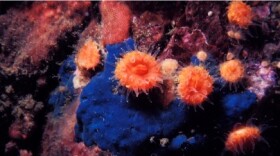It used to be the case that people who harvest shellfish could breathe a sigh of relief in late autumn. Spring, summer and even early fall have long presented the right conditions for harmful algae to grow and produce biotoxins in waters along the Washington state coast and into Puget Sound.
But in recent years, recreational and commercial harvesters, state agencies and tribes are noticing biotoxin outbreaks more commonly in the winter, too.
“We’re just seeing that the window of opportunity for these biotoxin closures are expanding,” said Elizabeth Tobin, who is the shellfish program manager at the Jamestown S’Klallam Tribe.
The Jamestown S’Klallam Tribe has an expansive treaty area for shellfish harvest. Where a tribal citizen might be harvesting shellfish can greatly impact whether or not treaty shellfish resources might be impacted by biotoxins from harmful algal blooms.
Although the state has noticed more biotoxin activity this year for recreational harvest, Tobin said the tribe hasn’t experienced increased closures associated with biotoxins in comparison to previous years.
The tribe has had patterns of short term closures consistent with previous year trends, she said. One area where the tribe harvests from, Sequim Bay, commonly experiences seasonal closures because of biotoxins.
The impact for the Jamestown S’Klallam Tribe is that the season of harmful algal blooms is getting longer. Warmer temperatures might be one factor at play for this change.
“Because we’re seeing warmer temperatures in general, we’re seeing this kind of seasonality of when these harmful blooms might occur that cause the toxins to expand,” Tobin said.
That means tribes are having to do more frequent biotoxin testing to ensure safe treaty harvests, she said. While tribes don’t have to pay for tests for subsistence harvest, the labor and time still has a cost.
The standard operating practice for the Jamestown S’Klallam tribe is to collect phytoplankton samples weekly, to see if species that produce toxins, such as paralytic shellfish toxins and diuretic shellfish toxins, are present.
Every seven to 10 days, they also go out on the beaches where there is a lot of active treaty harvest. The tribe collects and sends in shellfish samples for testing. That supports their commercial, subsistence and ceremonial harvest.
“When we start seeing that overall throughout the region, the levels of biotoxins are decreasing to undetectable, then we may decrease our frequency of testing and sampling, but we will keep on that weekly testing schedule probably through November,” Tobin said.
With biotoxin events occurring later in the year there might be more limited harvest opportunities.
That’s been the case for the Suquamish Tribe’s ability to harvest geoduck from central Puget Sound.
“We’ve had very small windows of opportunity where the levels dropped low enough that we could go out and harvest, but then it seems to pick right back up where we’re going to be months without being able to access some of these areas,” said Viviane Barry, the shellfish program manager for the Suquamish Tribe fisheries department.
That has a big impact on the labor force behind the harvest, the tribal members who dive and harvest geoduck for the tribe on contract.
“When they can’t go out on the water for months at a time, they don’t have an income,” Barry said.
Under management plans developed with the state, the tribe gets a poundage share of the annual harvest. When the tribe can’t harvest the tribal share of the annual quota, the remaining amount may carry over to the next year upon co-managers’ agreement.
“Even if we’re able to carry over the pounds to the next year, that doesn’t pay this year’s monthly bills and food,” Barry said.
Last year, the tribe didn’t meet the quota, so the remaining amount carried over to this year.
“We thought maybe we’d have better luck and we would be able to harvest those pounds early on,” Barry said. “We were able to do so a little bit, and then we’re seeing closure again.”
The tribe, along with other Puget Sound tribes and state co-managers, have lowered harvest rates for geoduck in some areas for conservation purposes.
Across the waterways and different species, the impact varies greatly.
“In general, the Swinomish beaches and the Swinomish shellfish farm very rarely, rarely close due to biotoxins as opposed to other areas,” said Julie Barber, the senior shellfish biologist for the Swinomish Indian Tribal Community.
The tribe can harvest on beaches on and off the reservation. Beaches on the reservation aren’t open everyday for harvest. When the tribe is preparing for a harvest, they send in samples to ensure it is safe.
Sometimes, there might be recreational closures for sport harvest for the state in regions where a tribe is still able to harvest. That’s true right now in Similk Bay, where the Swinomish Shellfish Company is still open. But the company is testing often to ensure safe product.
Being so near Deception Pass, Barber said there is a lot of water movement in that area. She hypothesizes that might help prevent algae growth.
Just last week, Cornet Bay in Deception Pass had some clams fail a test for paralytic shellfish poison toxins. The Swinomish tribe will be doing another test at the end of the week.
Barber said if the clams come back hot, meaning the shellfish contain toxin levels over the limit, that will be the first time in years that they will have had to close that beach.
Temperature, wind, tidal influx and precipitation all play a role in influencing if harmful algae is able to bloom or not, Tobin said.
But there is not one clear factor for why the probability of a biotoxin event produced by algae is occurring more frequently at different times of the year.






